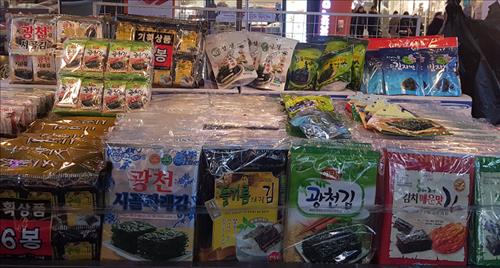
Korean dried seaweed pressed into sheets are sold at a street vendor in Myeongdong, a famous shopping district in downtown Seoul. (Image : Yonhap)
SEOUL, Jan. 20 (Korea Bizwire) – What’s your favorite way to eat dried seaweed?
If you are a Korean, you may want to have a bowl of rice with dried seaweed, roasted with sesame oil and fine salt, and kimchi. Dried seaweed pressed into a dark green sheet is called “kim,” a homonym for the most common family name in Korea.
If you are in the United States, try a package of crispy seaweed as a not-so-guilty snack. It’s high in vitamins and minerals, and naturally salty, so it goes well with beer.
With its origins tracing back to the 15th century in Korea, the traditional dining staple has long been served as a side dish, condiment and main ingredient in “kimbap,” Korean rice rolls.
But it has been increasingly spotted in snack sections in Western grocery stores, coming in many forms — baked or roasted for a portable snack or sliced for salads and soups.
Once considered a quirky food, dried seaweed is seeking to expand its territory from the local culinary scene to everyday snacks in the West as more consumers are becoming aware of its health benefits.
To capitalize on the latest trend, several Korean food producers have sold seaweed in a more universally appealing snack format, with the same nutritional benefits.
Buoyed by strong sales in flavored products, South Korea exported US$300 million worth of dried seaweed in 2015, surpassing the mark for the first time, according to the Ministry of Oceans and Fisheries. The amount was also triple that of 2010, making dried seaweed the second-most exported Korean seafood after tuna.
Shipments to the U.S. were the largest with a quarter of the total, followed by Japan, Thailand and China. Middle Eastern nations, including the United Arab Emirates and Saudi Arabia, were also included among export destinations, the ministry said.’
Sales in the U.S. have steadily increased over the past years on rising interest in healthier snacks, while they are becoming more popular in China and Southeast Asian nations thanks to the popularity of Korean pop culture.
“Food producers have developed various flavors and textures for seaweed to target the growing snack market in the U.S. and other Asian nations,” said Park Jun-hyo, an export division official at the fisheries ministry.
While Japan has sold dried seaweed for rice rolls and Thailand has a strong foothold in the snack market, Korean food producers are seeking to appeal to a larger audience by offering more variety in flavors and textures.
“Korean companies are well-known for their dried seaweed producing skills that create a crunchy, savory taste, while Japanese producers are more focused on making products for restaurants and rolls,” said Yoo Seung-ho, an export manager at Samhae Commercial Co., a mid-sized seaweed producer. “Once people taste it and get to know how to incorporate it into dishes, the dried seaweed market is expected to grow down the road.”
An unconventional take on seaweed snacks is fusing the traditional dried laver with flavors ranging from barbecue, wasabi, hot chili and squid.
In 2011, Dongwon F&B, the nation’s largest dried seaweed producer, launched three dried seaweed products called “Sea Veggies” in North America, selling them through Kroger’s 2,700 outlets.
“The seasoned dried seaweed has been promoted as a healthy snack that can replace potato chips and popcorn, with fewer calories and lots of vitamins,” said Lee Jong-eun, a Dongwon official. “Although seaweed snacks are still a rarity in the domestic market, it has become a mainstream snack choice in the U.S., Thailand and China.”
Dongwon F&B plans to expand its sales channel to major chains, such as Walmart, while working on securing halal food certifications to tap into the Middle East.
“While the Middle Eastern market is only at an embryonic stage, we have set our sights on its growth potential,” Lee said.
In July 2015, CJ Cheiljedang Co., South Korea’s largest food company, released a seafood snack that layers traditional dried laver over crispy brown rice chips.
In the U.S. market, it partnered with Annie Chun’s, a major producer of seaweed chips, to target the quickly growing seaweed snack category. Outside North America, the chips are sold under its Korean food franchise chain name “Bibigo” in 20 other nations, including China, England and Singapore.
“As the number of healthy snackers is fast rising, crispy seaweed snacks have expanded their presence in the snack market abroad, especially in the American market,” Kim Hyun-dong, CJ Cheiljedang’s spokesperson, said. “We plan to have various promotional events in major retail chains for global expansion.”
In response to the growing popularity of dried seafood, experts say food producers should find ways to make them healthy, yet indulgent options.
“Non-sugary snacks closely aligned with meal-replacement foods are showing strong growth, which signals a shift in the consumer mindset to one focused on health,” Susan Dunn, a senior researcher at Nielsen Global Survey of Snacking, said in a report.
Nielson said Europe and North America make up the majority of worldwide snack sales, but annual snack sales are growing faster in the largely developing regions, including the Asia-Pacific and Latin America.
“While conventional cookies, cakes and confections still hold the majority of snack sales, more innovation in healthy snacking and portable food space is necessary to adjust to this changing dynamic,” Dunn said.
The fisheries department has also rolled up its sleeves to fuel and reinforce the latest trend to expand exports to the U.S., China and the European Union, which have forged free trade agreements with South Korea.
In a 2016 policy plan, the government vowed to cooperate with the fisheries community for product development and overseas marketing through TV commercials and overseas trade fairs to promote the national brand called “K-fish.”
In case of China, the ministry plans to strengthen cooperation with quarantine officials for speedy procedures and establish cold chain logistics in partnership with Korean companies that have networks in the fast-growing market.
In addition, the ministry is also mulling ways to promote dried seaweed’s Korean term, kim, because it is more widely known as “nori,” a Japanese term, in the West.
“If foreigners start calling dried seaweed ‘kim,’ it could help promote consumption of Korean brands,” the ministry official Park said.
(Yonhap)






